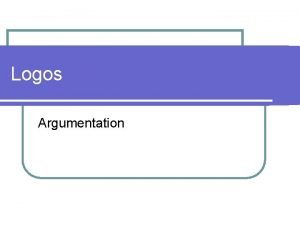Argumentation Strategies 5 Argumentation Strategies 1 Compare and








- Slides: 8

Argumentation Strategies

5 Argumentation Strategies 1. Compare and contrast 2. Consider Limitations and Objections 3. Consider Problems and Solutions 4. Describe 5. Narrate

Compare and Contrast ● Describing the similarities and differences between the main topic (something new) and a more familiar topic ● Helps the audience understand a new concept ● Use when the audience is probably not familiar with your topic “Critics of gay marriage would be wise to learn the history of institutional homophobia in America and how it helps drive today’s gay rights movement, just as institutional racism inspired and drove the civil rights movement. ” (Lampo, The American Conservative)

Consider Limitations and Objections ● Can show that you are balanced and trustworthy ● Don’t use too much “While computers are very useful in a classroom, they can also be very distracting, so teachers should make sure students stay on task. ” ● Use when the counterpoint is very important or obvious

Consider Problems and Solutions ● Focuses on the real-world applicability or usefulness of your argument “Obesity is a huge problem that can lead to heart problems and diabetes. Exercise and a healthy diet can not only make you feel better but also prevent obesity. ” ● Use when your topic can be the solution for a common problem, ESPECIALLY if your audience has this problem

Describe ● Using descriptive details and imagery ● Makes a topic more “real” “Millions of children go to home every day afraid to find out the mood of their parent. Afraid they may find them surrounded by beer bottles, holding a belt. ” ● Use when the audience is not directly experiencing something and you want to activate their sympathy

Narrate ● An anecdote or story that demonstrates your point ● Shows how your topic applies to real people “Not long ago, a young Ohio woman named Trina Bachtel, who was having health problems while pregnant, tried to get help at a local clinic. Unfortunately, she had previously sought care at the same clinic while uninsured and had a large unpaid balance. The clinic wouldn’t see her again unless she paid $100 per visit which she didn’t have. Eventually, she sought care at a hospital 30 miles away. By then, however, it was too late. Both she and the baby died. ” (Krugman, The New York Times).

Conclusion ● All of these are useful but serve different purposes ● A good argument paper will use at least 3 of these strategies (but more is better!)















